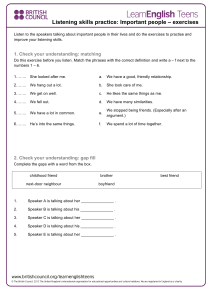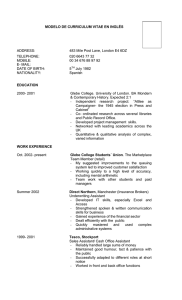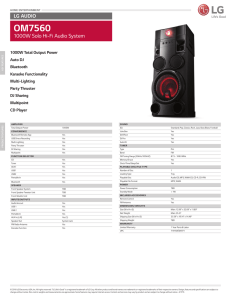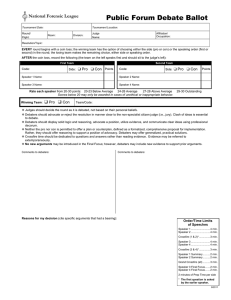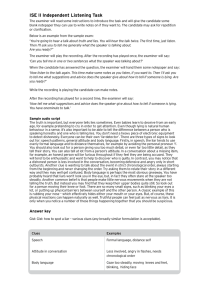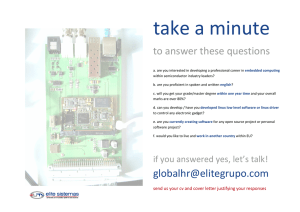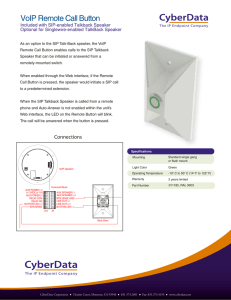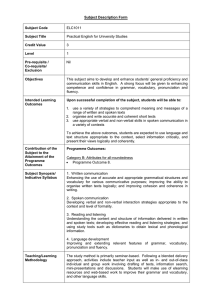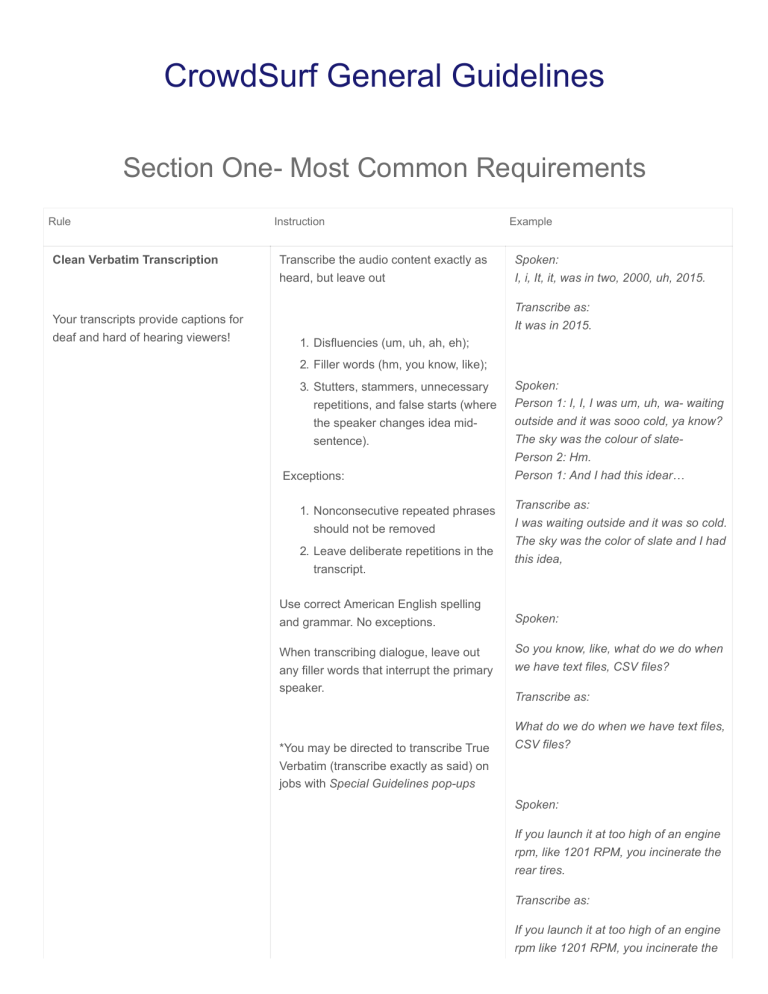
CrowdSurf General Guidelines Section One- Most Common Requirements Rule Clean Verbatim Transcription Your transcripts provide captions for deaf and hard of hearing viewers! Instruction Transcribe the audio content exactly as heard, but leave out Example Spoken: I, i, It, it, was in two, 2000, uh, 2015. Transcribe as: It was in 2015. 1. Disfluencies (um, uh, ah, eh); 2. Filler words (hm, you know, like); 3. Stutters, stammers, unnecessary repetitions, and false starts (where the speaker changes idea midsentence). Exceptions: 1. Nonconsecutive repeated phrases should not be removed 2. Leave deliberate repetitions in the transcript. Use correct American English spelling and grammar. No exceptions. When transcribing dialogue, leave out any filler words that interrupt the primary speaker. *You may be directed to transcribe True Verbatim (transcribe exactly as said) on jobs with Special Guidelines pop-ups Spoken: Person 1: I, I, I was um, uh, wa- waiting outside and it was sooo cold, ya know? The sky was the colour of slatePerson 2: Hm. Person 1: And I had this idear… Transcribe as: I was waiting outside and it was so cold. The sky was the color of slate and I had this idea, Spoken: So you know, like, what do we do when we have text files, CSV files? Transcribe as: What do we do when we have text files, CSV files? Spoken: If you launch it at too high of an engine rpm, like 1201 RPM, you incinerate the rear tires. Transcribe as: If you launch it at too high of an engine rpm like 1201 RPM, you incinerate the Rule Instruction Example rear tires. Spoken: I don't think, Paul, I don't think that's the case. Transcribe as: I don't think, Paul, I don't think that's the case Transcript Format 1. Always capitalize the first letter of 1. Beginning of HIT 2. End of HIT the first word in a HIT, even if it's not the start of a sentence. 2. Always close a HIT with a period, unless you're sure that it's the middle of a sentence, then leave it open or with a comma. 3. Never close a hit with a dash (- or -) or ellipses (...). Transcript Style Consistency is key! 1. Use the video to guide style, formatting (i.e. capitalization), and spelling in your transcript. 2. If the speaker references something on screen, transcribe it as shown. 3. Transcribe elements of a computer interface as they appear on screen. 1. To send the report. I need it by tomorrow morning at 2. We will call them back tomorrow. Rule Instruction Sentence Format So tomorrow we will see the 1. Always capitalize the first letter of the first word. 1. Beginning 2. Punctuation 3. Interruptions 4. Dialogue 5. Spacing 6. Sentence Breaks Example 2. Separate sentences with a period. 3. Use a dash to indicate an abrupt Challenger>> Yes, the Challenger Jobs Report. Spoken: >> But before I can do the install, I- interruption mid-sentence by > >> Mm-hm. another speaker. Never use a dash >> Have to first make sure the server is to indicate a stutter. Leave out stutters in Clean Verbatim. up- 4. With spoken dialogue do not >> Mm-hm. >> And running and then transcribe verbal tics (like habitual mm-hms) that interrupt the primary speaker’s sentence. 5. Use a single space between sentences. 6. Break up run-on compound Transcribe as: But before I can do the install, I have to first make sure the server is up and running and then sentences, and join fragments into complete sentences when possible. Spoken: Now you can see that once again we've got, you know, the preview going on if I Do your best to make coherent sentences out of the speaker’s speech patterns. It is perfectly acceptable to start a sentence with ‘And’ or ‘But’ in CrowdSurf transcripts. click submit you can see that it does not ah, make uh, it, it doesn't make a request, and query string, you can see actually, that when I click submit, uh actually, it's gonna, you know, make the network request in the background. Transcribe as: Now you can see that once again we've got the preview going on. If I click submit you can see that it does not make a request, and query string. You can see actually, that when I click submit, actually, it's gonna make the network request in the background. Rule Instruction Names and Industry Jargon Example Massachusetts, freemium 1. All person, product, and company names must be spelled and Use the CrowdSurf Glossaryfor help with technical terms. formatted correctly. 2. If unsure of the spelling, Google The people working at Apple are very nice. the word. Capitalize all place names and proper nouns. Exception: Some company, software and other names are not capitalized or W3 Communication is located over there. contain unique titles with numbers etc. Represent them as they represent My iPod is broken. themselves. Note that the logo is separate from the company name. Speaker Change Flag for tasks with Multiple Speakers Hey Charlie. >> Hello Amy, how are 1. Each time there is a new speaker in the media, indicate the change with a double chevron >> 2. If only one speaker, do not use a >> in the transcript. 3. If more than one person is talking at the same time, use your best judgment as to where to put the >>. 4. Where the dialogue is not transcribable due to overlap use [CROSSTALK]. 5. Use >> to indicate a change in speaker with human-made sounds like [LAUGH], [COUGH], [APPLAUSE], etc. you? >> Just fine Charlie. >> [LAUGH] Rule Punctuation Marks Instruction Example Do not use 1. quotation marks (“ “), 2. semi-colons (;), I was talking to him and he said yeah, 3. colons (:), I'd love to go see The Wizard of Oz. 4. ellipses (…), 5. em-dashes (--) in CrowdSurf transcripts. Exception: If specifically shown onscreen in a title or a line of code, then these punctuation marks may be included. Silence, Sounds and Non-Verbal noises Check your sound settings before 1. Use one tag per uninterrupted submitting [BLANK_AUDIO]. period of silence, sound, music, or non-verbal noises. All plot-relevant audio content should be recorded in your transcript. 2. Use bbb (for BLANK_AUDIO) when there is no audio, silence, or non-relevant sounds (like static) All sound tag shortcuts available on the right side of media tool. Do not make up your own tags. for 2 seconds or more in a clip. 3. Use mmm (for MUSIC) to indicate music and singing in the media. Do Spoken: I know that we all want to work not use this for background music towards equality, (audience applauds played simultaneously with speaker. Insert a music tag when there is only music or song for 2 seconds or more in the media. for a second or two, overlapping the speaker's next word or phrase] but it's not always easy when 4. Use speaker changes with ccc (for COUGH), lll (for LAUGH), aaa (for APPLAUSE), etc. 5. Use sss (for SOUND) or nnn (for NOISE) for distinct, plot-relevant noises in transcripts. 6. Use Aah! to indicate a scream. Transcribe as: I know that we all want to work towards equality, >> [APPLAUSE] >> But it's not always easy when Rule Instruction Static In Audio Example [BLANK_AUDIO] Ignore it. Don't type sss to denote sound. If the clip is nothing but static, then use bbb. Noisy Lecture Halls [BLANK_AUDIO] Ignore it. Don't type sss or nnn to denote the noise. (It is not relevant to the content of the lecture) If the clip contains unintelligble crowd noise, please use bbb. Audio Issues and Cut Off Words 1. If the audio quality is too challenging, please skip the HIT. 2. If the cut-off word is obvious based on the portion of it you heard and the context of the sentence, then complete the word. 3. If you cannot discern the cut-off word, type iii or [INAUDIBLE]. 4. If the word is cut off at the beginning and you can't hear it, do not type anything. Back to the top Section Two- Spelling & Grammar 1. Accepted Spellings As part of Clean Verbatim transcripts, spelling should adhere to the following rules: Correct All right Incorrect Alright Example All right, are we ready to get started? Correct Incorrect Okay / OK button Kay, ok, Mkay Example Okay, when you’re ready to get started click OK. Mm-hm Mmm hmm, Mmhmm, Mm-hm, I agree. Mm-hm. Uh-huh Uh huh, Uhuh Uh-huh, I understand you. etc. etcetera Use webinars for classes, presentations, sales, etc. Back to the top 2. Accepted Slang Our system will automatically correct the following slang terms, transcribe them as spoken. Example: speaker says "kinda", transcribe as kinda not kind of. If they say "kind of", transcribe as kind of. If not included in this list, please transcribe the full, correct word as shown in your favorite dictionary. Example: speaker says ‘em, always transcribe as them. Correct Incorrect Yeah Ya, yea Cuz Cause, cus Yep Yip, yeap Gonna Going To Kinda Kind of Sorta Sort of Wanna Want to Gotta Got to Back to the top 3. Contractions Rule Instruction Example Rule Instruction We'll vs. Well 1. We'll is a contraction of we will, without the apostrophe, well, has a different meaning. Let’s vs. Lets Example 1a. We'll meet in the morning. 1b. You have done well on this assignment. 2. Let's is a contraction for let us, without 2a. Let's go to the beach tomorrow the apostrophe, lets, is a synonym for 2b. This ski pass lets you ski all season. allows. I'm vs. Im 3. I'm is a contraction of I am, i’m and Im 3. I'm looking forward to the weekend. are not correct. Should’ve vs. Should of Who’s vs. Whose 4. Should’ve is a contraction of should 4. You should’ve been there, it was have, should of is not correct. awesome! 5. Who’s is a contraction of who is, I know a woman whose kids study there. whose is a possessive of who. >> Who’s that? Back to the top 4. Homophones Rule Instruction 1. It’s 2. Its 1. ‘It's’ is a contraction of the words it is. Example 1. It's cold out today. 2. The dog is looking for its owner. 2. ‘Its’ is a possessive pronoun. 1. Your 2. You’re 1. The word ‘your’ is the possessive form of you 1. Your dog is so playful. 2. You're welcome. 2. ‘You're’ is a contraction of the words you are. 1. There 2. Their 1. Use ‘there’ when referring to a location or direction. 1. He is over there. 3. They’re 2. Use ‘their’ to indicate possession. 2. I accidentally crashed into their car. 3. ‘They're’ is a contraction of the words they are. 3. They're going to be happy to hear the good news. Rule Instruction Example 1. To 1. ‘To’ indicates direction or action. 1. Please go to the store. 2. Too 2. ‘Too’ means also, very or 2. This class is too difficult. excessively. 3. Two 3. I have two young children. 3. ‘Two’ is a number. 1. Then 1. Then refers to time. 2. Than 2. Than is usually used to indicate comparisons. 1. He was about to leave, but then got distracted. 2. She is more helpful than you. Back to the top Section Three- Punctuation Rule Instruction Example General Punctuation 1. Use proper punctuation whenever possible. 2. Begin all HITs with a capital letter, end all HITs with a period. Exception: If you are confident the HIT ends mid-sentence leave the sentence without punctuation. Discouraged Punctuation Marks I just read The Hunger Games. 1. Em-dash -2. Ellipses … 3. Quotation Marks “ “ 4. Semi-colon ; 5. Colon : Exception: When punctuation is shown on screen in computer programming media, on-screen formatting takes precedence over punctuation rules. She said my email address is support@crowdsurfwork.com. Rule Instruction Example Speaker Interruption Jiminy Crick1. Use an en-dash to indicate a mid- >> Oh my! sentence interruption by a second speaker 2. Do not use an en-dash if the speaker interrupts him/herself. Punctuation and Numbers 1. Do not use an apostrophe with 1. The 60s were an exciting time in the ages or decades. US. 2. Do not use a dash with number 2. You should exercise every day for ranges, spell out ‘to’ or ‘through’. Sentence Style & Breakpoints 30 to 40 minutes. Too long: 1. Break up run-on sentences. Okay, now you can see that once again 2. Join sentence fragments. we've got the preview going on, if I click 3. Think about how your sentences will be displayed on screen as video captions. Submit you can see that it does not make a request. Too short: Okay. Hint: Generally 40-60 characters is the Now you can see that once again. optimal sentence length. We’ve got the preview going on. If I click Submit. Ideal Transcript: Okay, now you can see that once again we've got the preview going on. You can see that it does not make a request. If I click Submit you can see that it does not make a request. Back to the top Section Four- Numbers Write out numbers zero through ten, numbers above ten represent with numerical digits. Rule Instruction Example Rule Writing Out Numbers zero through ten Instruction Write out all numbers zero through ten, unless they are part of the following: 1. Court rulings (4-3), 2. Sports records (10-7-0), 3. Height measurements (6'9") 4. Mathematical or scientific equations or computer code (transcribe as seen in lecture slides) Example These are two of the ideas that I want to share. Spoken: Two times two equals four. Shown on screen: 2x2=4 Transcribe as: 2 x 2 = 4. 5. Time (12:15PM) 6. List (1. Sign up 2. Log in...) 7. Biblical references (John 3:16) 8. Storage units (1 GB) 9. Binary (0101) 10. Dates (April 7th, 2015) Numerals for Numbers 11 and above 1. Write numerically all numbers between 11 and above. 2. For numbers above 999,999, substitute million, billion, etc. for the zeros. Incorrect: This new policy will affect roughly 400 thousand people in New Mexico. 1. Their tour will stop in 21 cities around North America. 2. This new policy will affect roughly 400,000 people in New Mexico. 3. She’s got 1 million new followers on Twitter. Rule Instruction Imprecise Number Amounts 1. For imprecise numerical amounts spell out the numbers. Example Spoken: We need to raise a hundred dollars. Transcribe as: We need to raise $100. 2. This applies when the speaker is estimating or using an exaggeration which is not intended to be a precise quantity. Examples: a few hundred, a few thousand, a million Spoken: The team raised a few hundred dollars. Transcribe as: The team raised a few hundred dollars. Spoken: I've got about a billion things to do today. Transcribe as: I've got about a billion things to do today. Range of Numbers and Consistency 1. Do Not use a dash, always spell out “to” 2. Use consistent formatting within sentences, use numerals (when at least one of the numbers is over 10) 1. The President will need 60 to 70% approval rating in the polls. 2. Skip ahead 10 to 20 frames and click Play. for quantities with related units, lists, or numbers with a statistical relationship. Ordinal Numbers – First, Second, Third, etc. Roman Numerals 1. Spell out the word for first through tenth. 1. I will be visiting their second grade class on June 25th. 2. Use numerals for 11th and above. 2. She was first woman admitted in the 19th century. Use Roman numerals to describe sequences like in wars, events, or people. World War II, King John II, Super Bowl XLIX Rule Instruction 1. Use the numeral followed by Percentages ‘%’, unless speaker uses a fraction of a percent. 2. Exception: Do not use ‘%’ if a number is not associated with it. Example 1. 57% 2. What percent correct do I need to get an A in this class? Spoken: We’re seeing an increase of a quarter of a percent versus last year’s increase of twelve percent. Transcribe as: We’re seeing an increase of a quarter of a percent versus last year’s increase of 12%. Decimal Numbers If the number is less than one, 0.7 seconds, 0.5% then use a leading 0 before the decimal point. Year No apostrophe necessary when referencing the time period. The 1980s, the 60s Age Don’t add zeros when referencing age range or quantity. She is probably in her thirties. He wrote hundreds of pages. Back to the top Section Five- Sound Quickies Sound Quickies are for representing nonverbal parts of media. There are several rules to follow; Use sound tags to indicate sound, noise, music, or periods of silence in transcripts. One tag per section of uninterrupted sound. Transcribe all plot-relevant sounds, music, blank audio to describe the audio content of the media. For example, if the HIT is primarily a gun fight with the musical soundtrack played simultaneously in the background, transcribe [NOISE] for the gunfight, ignore the music. Type short code in all lowercase letters mmm and all Tags in uppercase [MUSIC]. All else will be incorrect. Do not add punctuation after standalone sound tags. Rule Instruction Example Rule Instruction Blank Audio Example bbb or [BLANK_AUDIO] 1. Use when there is silence, no Blank Audio tags are imperative for correct timing of video plot-relevant audio, or just static in a HIT. Example: If a professor is flipping pages, captions. typing, writing on the board, or clicking through slides this should be blank audio, not sound. 2. Verify that the video has loaded correctly and that computer audio settings are correct. 3. OR use [BLANK_AUDIO] to indicate a lapse of 2 or more Spoken: So now you see I’ll add in twenty pixels (typing noise for 1 second) of padding on each side (typing noise for 4 seconds) there you go On screen: padding: 20px; Transcribe as: So now you see I’ll add in 20px of padding on each side. [BLANK_AUDIO] There you go. seconds or more of no speech. Indiscernible Audio Notation can be used to replace one (Try to use as rarely as possible) word, or a phrase that cannot be heard. iii or [INAUDIBLE] Incorrect Format examples: [iii], (iii), Iii, III, sp, sp?, [sp], xx, [x], etc Crosstalk (Two or more speakers talking at once) Use when two or more speakers talk ttt or [CROSSTALK] simultaneously and their words cannot be distinguished. Incorrect: tt, TTT, (??), etc. Unknown (Try to use as rarely as possible) Guess You’re making a reasonable spelling guess based on the sound or context. If absolutely not sure of the word, uuu or [UNKNOWN] use uuu or [UNKNOWN]. Phonetically spell the word and append /g to the end. Google for correct spelling before using /g. Onomatopoeia/g Rule Laugh Instruction Speaker laughs or giggles. May be mid-sentence or a standalone tag. Use a speaker change between laugher and previous speaker. Example lll or [LAUGH] Spoken: So I told him to bugger off (second speaker laughs) or I'd have him arrested before he could say boo Transcribe as: So I told him to bugger off>> [LAUGH] >> Or I'd have him arrested before he could say boo. Music or singing mmm or [MUSIC] 1. Insert a music tag when there is only music or song for 2 seconds or more in the media. 2. Do NOT insert tag when music is playing in the background, simultaneous to speech. 3. Lyrics should only be transcribed when a pop-up message specifically instructs you to transcribe lyrics. If in doubt, only use a [MUSIC] tag. Sound sss or [SOUND] or nnn or [NOISE] 1. Use for distinct sounds. (Heard Phone Beep, Mechanical Noises, Distinct Background Sounds, sighs, non-verbal utterances etc.) 2. Do not use for static. Type bbb for all static or noisy lecture hall sounds. 3. Do not insert tag when sound is playing in the background of speaker talking. 4. Do not create your own sound tags for specific noises or human-made sounds. Rule Instruction Cough (Cough or throat clearing noise) Example ccc or [COUGH] 1. Use for coughing or throat clearing, mid-sentence or in a stand-alone sentence. 2. Do not transcribe if cougher is off-screen (i.e. if unidentified student coughs mid-lecture) 3. Use a speaker change flag to distinguish between cougher and previous speaker. Foreign Language fff or [FOREIGN] 1. Use in place of any language other than English, even if you are able to understand the foreign language. 2. You may be asked to copy English subtitles when prompted by Special Guidelines, no FOREIGN tag necessary in this case. Spoken: He has a certain joie de vivre about him. Transcribe as: He has a certain joie de vivre about him 3. Use a speaker change flag to indicate a change in speaker, even if in foreign language. Spoken: Je vois pas trop le rapport avec Marseille, mais bon, je vais cliquer sur. Marseille dans le Rhône, et là! Transcribe as: [FOREIGN] Applause aaa or [APPLAUSE] 1. Use for group clapping or cheering. 2. Incorrect Format examples: [applause] AAA (cheering) Rule Instruction Bleep Example xxx or [BLEEP] 1. Use only when media bleeps over an expletive. 2. Do not use if expletive is spoken in the media. 3. Incorrect Format examples: [xxx] (bleep) Back to the top Section Six- Currency and Time Rule Instruction Dollars and Cents Example I owe you $12 for lunch today. 1. Do not write “dollars” use $ sign for a quantifiable amount. 2. When less than $1 use the format $0.xx. Bucks If the speaker says ‘bucks’ instead The startup raised $1.2 million in round one. The profit margin is $0.50 per unit. 25 bucks of 'dollars’, spell out bucks. Foreign Currency When transcribing foreign currency, I just visited England and I have type out the word for it, rather than the symbol. 100 pounds left over from the trip. AM and PM 1:17 PM or 1 PM 1. Use AM and PM not a.m. and p.m. 2. If the time is on the hour, transcribe without :00 Rule Instruction 12 o’clock Military Time Example If the speaker says o’clock transcribe it as heard. 12 o’clock If spoken as x hundred hours, use the 00:00 format. 17:00 hours not 12:00 o’clock Back to the top Section Seven- Math & Science Capture the audio content of the HIT in your transcript, use the video to guide your formatting of any numbers, variables or terms that the speaker references. Go by audio first, use video for clarifications. Rule Instruction Example Equations Spoken: 1. Transcribe the equation as spoken, by the speaker. 2. Use the video to guide your formatting, spacing, and capitalization. Try to match your transcript to the video as much as possible. The slope of the secant line through a, f of a, and a second point a plus h f of a plus h provides an approximation when h is small. Shown on screen: The slope of the secant line Exception: CrowdSurf transcripts do through (a, f(a)) and a second point (a + h, f(a+h)) provides an not support the following symbols: approximation when h is small. Subscripts/superscripts (transcribe side-by-side p0) Greek letters (spell out pi, rho) Fractions (two-thirds) Special Characters like integral, derivative, square root. Transcribe as: The slope of the secant line through (a, f(a)) and a second point (a + h, f(a+h)) provides an approximation when h is small. Rule Notations (+,-,x, /) Instruction If not shown on screen, transcribe the spoken word instead of the symbol. (In math equations, still keep numbers as numerals even if under 10.) Example Multiplication: 4 times 7 equals 28. Division: 28 divided by 4 equals 7. Addition: 2 plus 2 equals 4. Subtraction: 2 minus 2 equals 0. Squared, Cubed, Power etc. For all equations involving exponential numbers, use the spoken word. 1. 4 to the 2nd equals 16 2. 3 to the 3rd equals 27 3. The square root of 4 equals 2 4. x to the nth equals 25 Negative Numbers If not shown on screen, for all mathematical notations involving 3 minus 4 equals negative 1. negative numbers, use the spoken word. Trigonometric Functions Spell out all trigonometric functions, do not abbreviate. 1. sine (sounds like sign) 2. cosine 3. tangent 4. secant 5. cosecant 6. cotangent Fractions For all mathematical notations 1 plus 1 and two-thirds equals x. involving fractions, transcribe the spoken word. Variables All mathematical variables (a, b, c, x, y, etc.) should be written lowercase Spoken: Um, e to the 2 pi i k, m minus n unless shown in the video or divided by capital N. specifically spoken by the instructor as uppercase. On screen: e 2 π i k (m - n) / N Transcribe as: e to the 2 pi i k (m – n) / N Rule Scientific Terminology, proper names Instruction Research name or term to ensure proper spelling. Example Leibniz notation Simply input the phonetic spelling of the term into your favorite search engine to check spelling. Transcribe your best guess and append the word with /g if you are not sure. Professor writing on board If the speaker makes noise while, Flipping pages, Writing on a board or projector screen, Or any typing noises and all else is silent for 2 or more seconds, transcribe as [BLANK_AUDIO]. Spoken: If we want to minimize J of theta (writes on board for 5 seconds) then we’ll need to take the derivative On screen: J(θ) = Transcribe as: If we want to minimize J(theta), [BLANK_AUDIO] Then we’ll need to take the derivative Back to the top Section Eight- Computers & Software Capture the audio content of the HIT in your transcript, use the video to guide your formatting of any buttons, tabs, or other elements of the computer interface. Rule Shift Instruction Shift Example Shift-click to select all of the files in the folder Rule Alt (And other keyboard combinations) Instruction Alt Example If it Sounds like : Hold alt, control, delete. Transcribe like this: Hold Alt+Ctrl+Delete Option Option Option+N creates the ñ character. Command Cmd Press Cmd+Z (Mac) to undo the last action. Control Ctrl Press Ctrl+Z (Windows) to undo the last action. Enter or Return Enter or Return Then hit Enter. Arrow up / arrow down Arrow up or arrow down Press the arrow up or arrow down keys to increase or decrease the pen diameter. Comma Spell out symbol keys like “comma” Press Ctrl+comma to increase the brush size. “Dot” and File names When a speaker says “dot” DO My email address is NOT spell it out, transcribe it with a period. xyz@yahoo.com. Transcribe the final version of the file name as it appears on screen. Spoken: I’ve uploaded the image dot P N G file. Transcribe as: I’ve uploaded the image.png file. Space bar Space bar F three Transcribe as the letter and numeral F3 double-click Double-click the border symbol to open it in symbol editing mode. (or any function key) Double-click Rule OK button Instruction Example Follow the spelling and formatting shown on screen in the computer I'm gonna go to the Emulate tab, select Mobile Devices option, then interface. click OK. e.g. Capitalize words that are shown as capitalized in the computer interface. Only use this spelling, OK, when referring to the computer command. CamelCase and code formatting Follow on-screen formatting in I will be using PowerPoint today. (Writing compound words or computer-related HITs. If a line of computer programming code Use the onCreate method. phrases so that each word begins with a capital letter.) shows specific spacing, capitalization, and punctuation, use the same in your transcript. Software names All software and company names Spoken: must be spelled correctly. If you are not sure, look it up to find V M ware was the first company to successfully virtualize the x eighty- correct spelling and formatting. six architecture. Use the CrowdSurf Glossary for Transcribe as: assistance. VMware was the first company to successfully virtualize the x86 architecture. File Path Instructions When the speaker instructs the Spoken: user to go to a menu or to press a certain combination of keys, use Go to File, then Documents, then Open. the following conventions, with a space on either side of the “>”. Transcribe as: Back to the top Section Nine- Internet & Contact Information Go to File > Documents > Open Rule Instruction Example Spelling a Name, Address, If a speaker spells out a last name My name is Christina, C-H-R-I-S-T-I- Word, etc. or street or something, indicate the recitation of letters with hyphens in N-A. between each letter. Internet URLs Internet must always be You must have a stable Internet capitalized. connection to work on Mturk. Transcribe the final web address Spoken: even if the speaker has completely spelled it out. You can find us at W S J dot com. Transcribe as: You can find us at WSJ.com Emails Transcribe the final email address even if the speaker has completely spelled it out. Spoken: My email is J O H N dot D O E at g mail dot com. Transcribe as: My email is john.doe@gmail.com. Telephone Number Transcribe the final telephone number in digits and dashes form. My cell number is (123)-444-5555. IP Addresses Transcribe the final IP address in 98.182.30.194 digits and periods form. Hashtags If used as a word in a sentence, spell out the word hashtag. If used in the format #blablabla use the pound sign, # Contact me at the hashtag shown below. Spoken: What’s your opinion? Let us know at hashtag CrowdSurf. Transcribe as: What’s your opinion? Let us know at #CrowdSurf. Twitter handles Back to the top Use the at sign, @, when someone references their twitter handle Find me on Twitter @AshleyEsqueda. Section Ten- Sample Transcripts! Rule Spoken Clean Verbatim Punctuation Currency and Time Correct Transcripts Yesterday at around twelve o clock I was, um, visiting, uh, Yesterday, at around 12 o'clock I was visiting Dr. Smith's office. And he doctor smith’s office and he wawas saying, “exercise is an important part of one's was saying exercise is an important part of one's cardiovascular regimen. cardiovascular regimen“ Speaker Change Flags Contact information Speaker 1: Let's welcome Mary to the call. Mary, how do you spell your last Let's welcome Mary to the call. Mary how do you spell your last name? name? >> W-O-R-T-H-I-N as in Nancy, G-TO-N. Speaker 2: W O R T H I N as in Nancy G T O N. >> And what’s your email address? >> Mworthington@hotmail.com. Speaker 1: And what’s your email address? Speaker 2: M Worthington at Hotmail dot com. Numbers Percentages Monetary amounts Numbers Slang Capitalization of proper nouns We've seen a fifty percent increase in our market share, representing over four million dollars in potential revenue We've seen a 50% increase in our market share, representing over $4 million in potential revenue. Don't you mean 5 point 1 million? Don't you mean 5.1 million, or are Or are you leavin’ out latin America? you leaving out Latin America? Rule Spoken Sentence breakpoints On-screen formatting Computer Coding Camel Case Correct Transcripts We give you the code for actually downloading the, uh, the image We give you the code for actually downloading the image. So it's called so its called download image, you give it a context and a url that you want to download, and it goes and does a bunch of magic to downloadImage. You give it a context and a URL that you want to download. And it goes and does a bunch of magic to download things. download things Shown on screen: (line of code) public static Url downloadImage On-screen formatting Math variables Sound tags The first property [clears throat], states that A to the N times a to the m equals a to the N plus M, The first property [COUGH] states that A to the n x A to the m is equal to A to the (n+m), and is often and is often referred to as the product rule. referred to as the Product Rule. Shown on screen: Product Rule: An x Am = A(n+m) Speaker change flags Speaker Interruptions Punctuation Spelling consistency Research unknown terms Speaker 1: Will we be discussing ciphertexts this Will we be discussing ciphertexts this semester? Or is- (interrupted by second speaker) semester? Or is- Speaker 2: Cypher texts, also known as encoded or encrypted information will be part of our discussion on touring machines and the different >> Ciphertexts, also known as encoded or encrypted information, will be part of our discussion on Turing machines and the different algorithms that are used in a computer's CPU. algorhythms that are used in a computers cpu. Sound tags Slang (violin note for 2 seconds) Okay, just went a little bit sharp. Now I’m [SOUND] Okay, just went a little bit sharp. Now I’m gonna give a tug for gonna give a tug for a little slack. And test it again. (violin note for 4 seconds) Perfect. a little slack. And test it again. [SOUND] Perfect.
